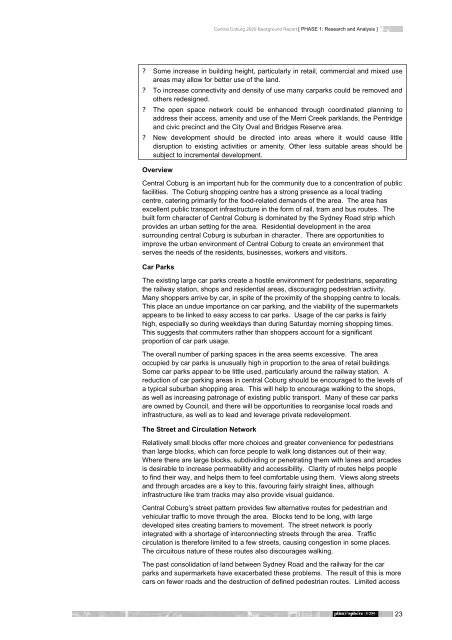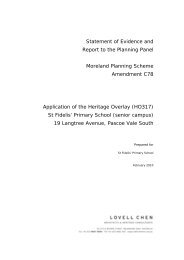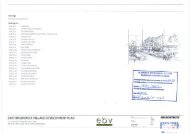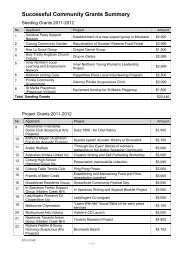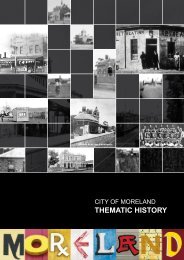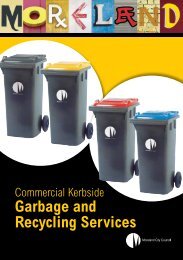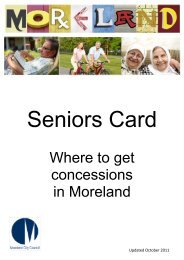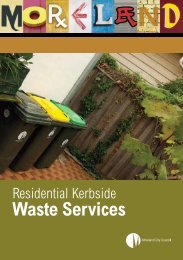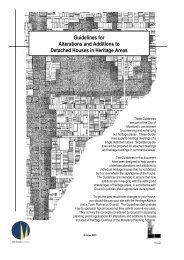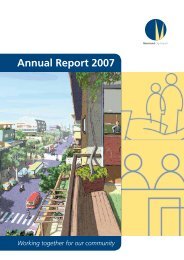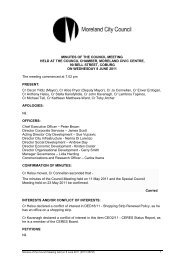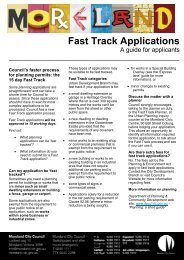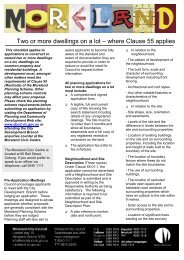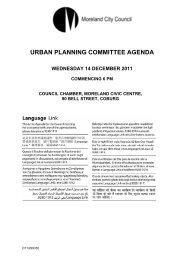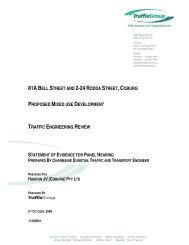Local Planning Policy Framework - Moreland City Council
Local Planning Policy Framework - Moreland City Council
Local Planning Policy Framework - Moreland City Council
You also want an ePaper? Increase the reach of your titles
YUMPU automatically turns print PDFs into web optimized ePapers that Google loves.
Central Coburg 2020 Background Report [ PHASE 1: Research and Analysis ]<br />
? Some increase in building height, particularly in retail, commercial and mixed use<br />
areas may allow for better use of the land.<br />
? To increase connectivity and density of use many carparks could be removed and<br />
others redesigned.<br />
? The open space network could be enhanced through coordinated planning to<br />
address their access, amenity and use of the Merri Creek parklands, the Pentridge<br />
and civic precinct and the <strong>City</strong> Oval and Bridges Reserve area.<br />
? New development should be directed into areas where it would cause little<br />
disruption to existing activities or amenity. Other less suitable areas should be<br />
subject to incremental development.<br />
Overview<br />
Central Coburg is an important hub for the community due to a concentration of public<br />
facilities. The Coburg shopping centre has a strong presence as a local trading<br />
centre, catering primarily for the food-related demands of the area. The area has<br />
excellent public transport infrastructure in the form of rail, tram and bus routes. The<br />
built form character of Central Coburg is dominated by the Sydney Road strip which<br />
provides an urban setting for the area. Residential development in the area<br />
surrounding central Coburg is suburban in character. There are opportunities to<br />
improve the urban environment of Central Coburg to create an environment that<br />
serves the needs of the residents, businesses, workers and visitors.<br />
Car Parks<br />
The existing large car parks create a hostile environment for pedestrians, separating<br />
the railway station, shops and residential areas, discouraging pedestrian activity.<br />
Many shoppers arrive by car, in spite of the proximity of the shopping centre to locals.<br />
This place an undue importance on car parking, and the viability of the supermarkets<br />
appears to be linked to easy access to car parks. Usage of the car parks is fairly<br />
high, especially so during weekdays than during Saturday morning shopping times.<br />
This suggests that commuters rather than shoppers account for a significant<br />
proportion of car park usage.<br />
The overall number of parking spaces in the area seems excessive. The area<br />
occupied by car parks is unusually high in proportion to the area of retail buildings.<br />
Some car parks appear to be little used, particularly around the railway station. A<br />
reduction of car parking areas in central Coburg should be encouraged to the levels of<br />
a typical suburban shopping area. This will help to encourage walking to the shops,<br />
as well as increasing patronage of existing public transport. Many of these car parks<br />
are owned by <strong>Council</strong>, and there will be opportunities to reorganise local roads and<br />
infrastructure, as well as to lead and leverage private redevelopment.<br />
The Street and Circulation Network<br />
Relatively small blocks offer more choices and greater convenience for pedestrians<br />
than large blocks, which can force people to walk long distances out of their way.<br />
Where there are large blocks, subdividing or penetrating them with lanes and arcades<br />
is desirable to increase permeability and accessibility. Clarity of routes helps people<br />
to find their way, and helps them to feel comfortable using them. Views along streets<br />
and through arcades are a key to this, favouring fairly straight lines, although<br />
infrastructure like tram tracks may also provide visual guidance.<br />
Central Coburg’s street pattern provides few alternative routes for pedestrian and<br />
vehicular traffic to move through the area. Blocks tend to be long, with large<br />
developed sites creating barriers to movement. The street network is poorly<br />
integrated with a shortage of interconnecting streets through the area. Traffic<br />
circulation is therefore limited to a few streets, causing congestion in some places.<br />
The circuitous nature of these routes also discourages walking.<br />
The past consolidation of land between Sydney Road and the railway for the car<br />
parks and supermarkets have exacerbated these problems. The result of this is more<br />
cars on fewer roads and the destruction of defined pedestrian routes. Limited access<br />
23


